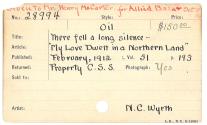Artist:
N.C. Wyeth
(American, 1882 - 1945)
There fell a long silence through which O'Hara read and Kenyon kept watch at the window.
Alternate Title(s):Rainy Sunday in Camp
Medium: Oil on canvas
Date: 1911
Dimensions:
34 1/8 × 25 1/8 in. (86.7 × 63.8 cm)
Private collection
Accession number: SUPP2000.665
Research Number: NCW: 665
InscribedLower left: N. C. WYETH (underlined); written on reverse of canvas: WYETH; adhered to reverse of canvas, a partial Scribner's label: (illegible)994 Wyeth, N. C ./ Kenyon stood looking out / of the window--; on top stretcher: No 5; on proper right stretcher: 22534-4
ProvenanceCharles Scribner's Sons, 1911-1916, inventory number 28994; Possibly sold or auctioned for war relief (see Scribner's card note); (?); Stimson Wyeth, Needham, MA; Mr. and Mrs. Elwyn Kittredge, Needham, MA; Mr. Robert B. Kittredge, Falmouth, ME; Private collection, Cambridge, MA, to May 2019; (NY, NY, Christies, May 22, 2019, lot no. 62)
Exhibition HistoryProbably Philadelphia, PA, 1912(1), no. 30, as "Rainy Sunday in Camp"; Haverhill, MA, 1913; Needham, MA, 1967, no. 15; Portland, ME, 2000, no numbers, p. 56; Chadds Ford, PA, Brandywine River Museum, "N. C. Wyeth and The Philadelphia Sketch Club," March 20 - May 23, 2010;
References
Douglas Allen and Douglas Allen, Jr., N. C. Wyeth, The Collected Paintings, Illustrations and Murals (New York: Crown Publishers, Inc., 1972), p. 275; Christine B. Podmaniczky, N. C. Wyeth, A Catalogue Raisonné of Paintings (London: Scala, 2008), I.369, p. 238
Curatorial RemarksAuthor Mary Synon was particularly pleased with the illustrations for this story, citing Wyeth's "sympathetic understanding of the North Country people" (Mary Synon to NCW, Jan. 24, 1912, Wyeth Family Archives).
The painting's association with Philadelphia, PA, 1912(1), no. 30, rests with the date of the painting, the pictorial matter, and the title in relation to the story which it illustrated. The episode in the story does take place in a Canadian transcontinental railway camp, on a rainy Sunday.
Up until at least 2019, the painting retained its original black-stained oak frame, just like those examples found in the artist's studio (see Podmaniczky, N. C. Wyeth, Catalogue Raisonne of Paintings, Scala Publishers and Brandywine River Museum, 2008, p. 58, fig. 29a). Before crating paintings for shipment to New York or Philadelphia, Wyeth applied these simple frames to protect the edges of the canvas.
The Scribner's card file reference to the Allied Bazaar is confusing. An Allied Bazaar for the benefit of war relief took place in June 1916, but the date on the Scribner's file card clearly reads "Oct 5/16".
The painting's association with Philadelphia, PA, 1912(1), no. 30, rests with the date of the painting, the pictorial matter, and the title in relation to the story which it illustrated. The episode in the story does take place in a Canadian transcontinental railway camp, on a rainy Sunday.
Up until at least 2019, the painting retained its original black-stained oak frame, just like those examples found in the artist's studio (see Podmaniczky, N. C. Wyeth, Catalogue Raisonne of Paintings, Scala Publishers and Brandywine River Museum, 2008, p. 58, fig. 29a). Before crating paintings for shipment to New York or Philadelphia, Wyeth applied these simple frames to protect the edges of the canvas.
The Scribner's card file reference to the Allied Bazaar is confusing. An Allied Bazaar for the benefit of war relief took place in June 1916, but the date on the Scribner's file card clearly reads "Oct 5/16".
Image Source for printed Catalogue Raisonne:Transparency directly from painting
Photo Credit:Dennis Griggs, 10/2000




